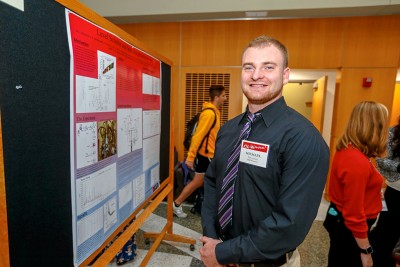It's Inauguration Week! Let the Fun Begin!
View details for Inauguration Day and access the full schedule of events.
View details for Inauguration Day and access the full schedule of events.

 Student: Michael Heeschen
Student: Michael Heeschen
Faculty Mentor: Robert Haring-Kaye (OWU Department of Physics and Astronomy)
Relatively little is known about the gallium-70 (70Ga) atomic nucleus, consisting of 31 protons and 39 neutrons, partly because of the difficulty to produce it abundantly in the laboratory. However, it is important to study such nuclei since contemporary theoretical models are becoming increasingly accurate in predicting the fundamental properties of nuclei as heavy as gallium. To provide a good test case for these models, we need to be able to measure and understand as many of these fundamental properties as possible, especially for systems that have not been studied much before. Thus the goal of this research was to measure quantities such as the energy and angular momentum (related to how fast the nucleus rotates) of 70Ga after it is produced in a nuclear reaction, so these properties can eventually be used to test the predictions of relevant theoretical models.
Currently, little is known about high-spin states in odd-odd 70Ga. However, a 9+ state was identified at 2887 keV, which could be the start of a high-spin rotational band based on a proton and neutron occupation of the g9/2 orbital. The goal of this work was to search for evidence of this structure. The 70Ga nuclei were produced following the 62Ni(14C, αpn) reaction at 50 MeV performed at Florida State University. The γ decays were detected in coincidence with a Compton-suppressed Ge array consisting of three Clover detectors and seven single-crystal detectors. Spins were assigned from measured directional correlation of oriented nuclei (DCO) ratios and their comparison with theoretical values. A new high-spin band based on the 9+ state was observed and appears to show rotational character. The behavior of the moment-of-inertia of this band is similar to that of other odd-odd nuclei in this mass region, but the signature-splitting pattern indicates an irregular phase reversal at high spin.